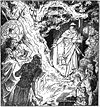Völsunga saga
The Völsungasaga (often referred to in English as the Volsunga Saga or Saga of the Völsungs) is a legendary saga, a late 13th century Icelandic prose rendition of the origin and decline of the Völsung clan (including the story of Sigurd and Brynhild and destruction of the Burgundians). It is largely based on epic poetry. The earliest known pictorial representation of this tradition is the Ramsund carving, Sweden, which was created c. 1000 AD.
The origins of the material are considerably older, however, and it echoes real events in Central Europe during the Migration period. On the other hand, the only manuscript of the saga, Ny kgl. Saml. 1824 b 4to, which is held by the Royal Library of Denmark, dates to about 1400. In this manuscript, the saga leads straight in to Ragnars saga loðbrókar.
The Middle High German epic poem Nibelungenlied is based largely on the old stories, which were commonly known in all of the Germanic lands from the early Middle Ages on, but reworks the material into a courtly medieval setting.
Among the more notable adaptations of this text are Richard Wagner's operatic tetralogy, Der Ring des Nibelungen, Ernest Reyer's opera Sigurd, and William Morris's epic poem The Story of Sigurd the Volsung and the Fall of the Niblungs.
External links
- R. G. Finch (ed. and trans.), The Saga of the Volsungs (London: Nelson, 1965), available at VSNRweb-publications.org. A fine translation with facing page Old Icelandic text and a good (if dated) introduction.
- Fornaldarsögur Norðurlanda and Völsunga saga in Old Norse from «Kulturformidlingen norrøne tekster og kvad» Norway.
- Read the Volsunga Saga Here, translated by William Morris and Eirikr Magnusson. Free audiobook from LibriVox
- Timeless Myths: Volsunga Saga
- The Story of Sigurd. The Volsunga Saga retold by Andrew Lang.
- Proverbs and proverbial materials in Völsunga saga
- Read the Icelandic Text and the English translation by Kaaren Grimstad

